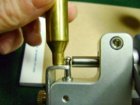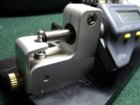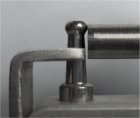You are using an out of date browser. It may not display this or other websites correctly.
You should upgrade or use an alternative browser.
You should upgrade or use an alternative browser.
measuring case neck thickness?
- Thread starter TrxR
- Start date
ballisticdaddy
Gold $$ Contributor
A ball micrometer is what has worked best for me
Mitutoyo 0-1" .0001 Ball Mic So ditto what ballisticdaddy said.
if you can find the Sinclair one that is attached to a stand at an angle( with the starrett micrometer) and has a post coming out of it, get it. I have one and LOVE IT!!!! got it on eBay for like 65 shipped!!!!!!!! measures to 1/10000th. its like having an extra hand. good luck and ymmv. bryant
bryant
P1ZombieKiller
Silver $$ Contributor
This is what I use. I used small rubber washers to set the case higher or lower depending on the caliber.




What are you all using or recommend for measuring case neck thickness when neck turning?
Thanks
Is there a reason why folks are posting pics of their preferred micrometer but NOT identifying make/model. I see the name Sinclair in one pic (discontinued by Sinclair), but nothing more in others.
Is it that whole "secret decoder ring" thing or what?
Last edited:
Truly it's not a difficult find:
http://www.6mmbr.com/casenecktools.html
https://www.google.com/search?hl=en...j0i67j0i10i67j0i8i30j0i24.Ug9x1XxW6Z8#imgrc=_
We do what we prefer with any of them.
http://www.6mmbr.com/casenecktools.html
https://www.google.com/search?hl=en...j0i67j0i10i67j0i8i30j0i24.Ug9x1XxW6Z8#imgrc=_
We do what we prefer with any of them.
Shynloco
You can lead a horse to water, but ........
Not meaning to hijack this thread, but in case anyone is interested, I have a relatively new Sinclair mic setup like the one Zombie Killer pictured. Used it once and put it away as I like the Mitutoyo Ball mic much more. So the almost new Sinclair is available to anyone who wants it...asking $125 shipped CONUS. Thx. (I posted the Sinclair Mic in Classified shortly after I bought it but no bites so she's sat in a box in my cupboard since.)
Alex
Alex
P1ZombieKiller
Silver $$ Contributor
Is there a reason why folks are posting pics of their preferred micrometer but NOT identifying make/model. I see the name Sinclair in one pic (discontinued by Sinclair), but nothing more in others.
Is it that whole "secret decoder ring" thing or what?
No secret..... there are several out there. Mine is a Fowler IP54 sitting on a Sinclair stand. There are several different makers, and several different ways you can set it up. Mine is actually not even a BALL MIC.... the "BALL" is part of the stand.
P1ZombieKiller
Silver $$ Contributor
Doesn't having/using a case mouth 'stop' defeat the idea of measuring at various points on the neck - both rotationally and up/down - so as to identify the thinnest part of the neck?
For me... I am not looking to measure every single piece of the neck. I do 30br mostly, so I know it takes at least a cut to .0105" to get a 95% cleaned up neck. That's why I recommend a min of .010" even for folks shooting a .332 neck 30br. So when I use my .xxxx" cutter, I measure after every case cut, and I measure it in the same spot Vertically on the neck for every case.
New necks are tapered in thickness. While unturned, the thinnest part is the case mouth, and thickest is donut area. So if you're not setting a datum line, your measure will vary on that alone. Always measure one thing at a time.Doesn't having/using a case mouth 'stop' defeat the idea of measuring at various points on the neck - both rotationally and up/down - so as to identify the thinnest part of the neck?
Our brass is thickest at webs and taper thins all the way to case mouths by method of manufacture.
With this, thickness variance runs from webs to case mouths.
We measure necks for both thickness and thickness variance.
You can turn away thickness variance at necks, but it's still running the remainder of case length.
Each time you size that variance, case runout grows, and before long you're making bananas for ammo.
This is the root cause of growing runout, so if you're intent on making straight ammo, you'll measure new necks for thickness variance, and cull out anything beyond 1/2thou as seen at any set datum.
And this is why a case stop is important for many of us (back to your concern).
As far as what matters for neck thickness itself; You determine this. It's your plan.
You probably want a set neck clearance, and consistent neck tension, including reducing sized or interfering donuts. This doesn't always mean you have to turn necks to get it. Depends on your brass, chamber, sizing, annealing plan.
I typically measure mid neck, with occasional measure on donut (just to know my thickness taper).
Believe me, if mid neck is thicker, donut is thicker as well. If there is variance at mid neck, donut and mouths vary as well. Both attributes are also offending shoulder to webs.

Forgive me, please, if I am slow...
Yesterday I opened a box of new 223 Rem Lapua brass. I understand it may generally taper from neck/shoulder junction to the mouth as a result of the manufacturing process. The new brass was very tight in the neck and was run through the 21st Century sizing die. I don't believe this mandrel is tapered in the area of interest - the nose is for obvious reasons, but the shank is, I believe, constant. (Maybe this is where I am wrong.) After resizing, ideally, the inside diameter of the entire neck is the same from mouth to the shoulder junction. If the interior diameter of the neck at the shoulder junction is not the same as, say, the midpoint then a constant cutting depth would 'eat into' the junction making it much thinner than elsewhere. Of course the outside diameter of the neck still has the taper from the manufacturing process and other anomalies. (If we can't normalise the interior surface and transfer abnormalities to the exterior surface turning isn't going to be effective.) I chose a diameter to cut to. If the cutting tool is any good it holds that cutting depth from shoulder junction to case mouth. The 21st Century tool seems to do a good job. If the depth isn't sufficient to remove the manufacturing taper or any other anomalies in thickness we will see uncut brass. If the entire neck is cut it ought to be the same thickness throughout. (Emphasis on ought. Obviously things are subject to tooling tolerances etc.)
So if you want to see a fully turned neck (no uncut, 'low-side') you have to measure all over the neck. Personally I am timid and I am not turning to a known custom chamber. (See below.) When I turned this box of new brass I set the cutting depth to give me 0.013". That left a good deal of uncut brass (maybe 25-30%). Most of the uncut brass was on one side of the case versus the other rather than always appearing towards the case mouth. I would estimate based on the measurements I took that turning to 12.5 thou would leave next to no unturned surface. I stopped where I did because if I measure the outside diameter of fired brass I get 0.2555". So, roughly speaking, I have 5.5 thou or more of release clearance already.
(I have a 6mm custom rifle build in the works - waiting on parts - and will be able to refine neck thickness for that known custom chamber which will assume I'm turning case necks. For my current rifles I understand there will be a trade-off between precisely turned necks and an oversized release dimension. But it is good to learn best practice now.)
I have a SPI 17-758-4. Link. I can see that the stands would be useful (a third hand). Engineering a stop for mine would be hard and have to be part of the stand. Like yours, a stop would have to be on only one side of the ball else it would interfere with the mic. But given the above comments I'm not convinced one is needed. (The anvil isn't adjustable either but I have to date taken the view that I would find the thinnest points further along the case neck, away from the shoulder junction and so the wouldn't matter so much.)
On another note, how often do you turn the same brass - one time deal or after x firings?
Yesterday I opened a box of new 223 Rem Lapua brass. I understand it may generally taper from neck/shoulder junction to the mouth as a result of the manufacturing process. The new brass was very tight in the neck and was run through the 21st Century sizing die. I don't believe this mandrel is tapered in the area of interest - the nose is for obvious reasons, but the shank is, I believe, constant. (Maybe this is where I am wrong.) After resizing, ideally, the inside diameter of the entire neck is the same from mouth to the shoulder junction. If the interior diameter of the neck at the shoulder junction is not the same as, say, the midpoint then a constant cutting depth would 'eat into' the junction making it much thinner than elsewhere. Of course the outside diameter of the neck still has the taper from the manufacturing process and other anomalies. (If we can't normalise the interior surface and transfer abnormalities to the exterior surface turning isn't going to be effective.) I chose a diameter to cut to. If the cutting tool is any good it holds that cutting depth from shoulder junction to case mouth. The 21st Century tool seems to do a good job. If the depth isn't sufficient to remove the manufacturing taper or any other anomalies in thickness we will see uncut brass. If the entire neck is cut it ought to be the same thickness throughout. (Emphasis on ought. Obviously things are subject to tooling tolerances etc.)
So if you want to see a fully turned neck (no uncut, 'low-side') you have to measure all over the neck. Personally I am timid and I am not turning to a known custom chamber. (See below.) When I turned this box of new brass I set the cutting depth to give me 0.013". That left a good deal of uncut brass (maybe 25-30%). Most of the uncut brass was on one side of the case versus the other rather than always appearing towards the case mouth. I would estimate based on the measurements I took that turning to 12.5 thou would leave next to no unturned surface. I stopped where I did because if I measure the outside diameter of fired brass I get 0.2555". So, roughly speaking, I have 5.5 thou or more of release clearance already.
(I have a 6mm custom rifle build in the works - waiting on parts - and will be able to refine neck thickness for that known custom chamber which will assume I'm turning case necks. For my current rifles I understand there will be a trade-off between precisely turned necks and an oversized release dimension. But it is good to learn best practice now.)
I have a SPI 17-758-4. Link. I can see that the stands would be useful (a third hand). Engineering a stop for mine would be hard and have to be part of the stand. Like yours, a stop would have to be on only one side of the ball else it would interfere with the mic. But given the above comments I'm not convinced one is needed. (The anvil isn't adjustable either but I have to date taken the view that I would find the thinnest points further along the case neck, away from the shoulder junction and so the wouldn't matter so much.)
On another note, how often do you turn the same brass - one time deal or after x firings?
Neck turning is only as difficult as we make it.
You don't have to downsize new Lapua necks. Run your turning system expander mandrel through a few culled cases(for whatever reasons). Take your feeler gauges and eek into desired turned thickness trial & error till it's right. Now you're ready to turn all your best cases.
As far as your beginning plan, desired neck thickness and/or % turned around necks,, you should pause to think about that. What matters to you?
After all, with so much neck clearance you don't actually need to turn at all. You can make ammo as straight as anyone with minimal sizing and running a mandrel through necks prior to every bullet seating.
You could normalize neck tension, even through varying neck thickness, with minimal neck sizing and regular process annealing. Just be sure to develop your loads with this.
If you want to turn necks, maybe just for the learning, then don't sweat the load. Skim turning will hit expanded high spots, and fire forming will hammer the lower thickness variance to the inside, and you can mandrel push this back out before bullet seating.
You could turn deeper & deeper until 100% of the neck is hit by the cutter. I don't know where that'll leave you for thickness, but excess neck clearance isn't free. Leave you sizing with excess..
Say you wanted to remove donut thickness. There is no better way to do this than outside neck turning new brass, but if necks don't need turning you can ream this much away. Different thread.
When turning for a tight neck chamber, the whole matter is as simple as setting desired thickness.
The micrometer measure just lets you see what have along the way. And you're right; you don't have to employ a neck stop for the measure. Just a suggestion. It doesn't hurt to do this, and I'm sure it's possible with whatever you're using(even a K&M).
You don't have to downsize new Lapua necks. Run your turning system expander mandrel through a few culled cases(for whatever reasons). Take your feeler gauges and eek into desired turned thickness trial & error till it's right. Now you're ready to turn all your best cases.
As far as your beginning plan, desired neck thickness and/or % turned around necks,, you should pause to think about that. What matters to you?
After all, with so much neck clearance you don't actually need to turn at all. You can make ammo as straight as anyone with minimal sizing and running a mandrel through necks prior to every bullet seating.
You could normalize neck tension, even through varying neck thickness, with minimal neck sizing and regular process annealing. Just be sure to develop your loads with this.
If you want to turn necks, maybe just for the learning, then don't sweat the load. Skim turning will hit expanded high spots, and fire forming will hammer the lower thickness variance to the inside, and you can mandrel push this back out before bullet seating.
You could turn deeper & deeper until 100% of the neck is hit by the cutter. I don't know where that'll leave you for thickness, but excess neck clearance isn't free. Leave you sizing with excess..
Say you wanted to remove donut thickness. There is no better way to do this than outside neck turning new brass, but if necks don't need turning you can ream this much away. Different thread.
When turning for a tight neck chamber, the whole matter is as simple as setting desired thickness.
The micrometer measure just lets you see what have along the way. And you're right; you don't have to employ a neck stop for the measure. Just a suggestion. It doesn't hurt to do this, and I'm sure it's possible with whatever you're using(even a K&M).
nmkid
Gold $$ Contributor
I got one and it's great for short neck cases.
Similar threads
- Replies
- 7
- Views
- 1,792
Upgrades & Donations
This Forum's expenses are primarily paid by member contributions. You can upgrade your Forum membership in seconds. Gold and Silver members get unlimited FREE classifieds for one year. Gold members can upload custom avatars.

Click Upgrade Membership Button ABOVE to get Gold or Silver Status.
You can also donate any amount, large or small, with the button below. Include your Forum Name in the PayPal Notes field.
To DONATE by CHECK, or make a recurring donation, CLICK HERE to learn how.

Click Upgrade Membership Button ABOVE to get Gold or Silver Status.
You can also donate any amount, large or small, with the button below. Include your Forum Name in the PayPal Notes field.
To DONATE by CHECK, or make a recurring donation, CLICK HERE to learn how.











